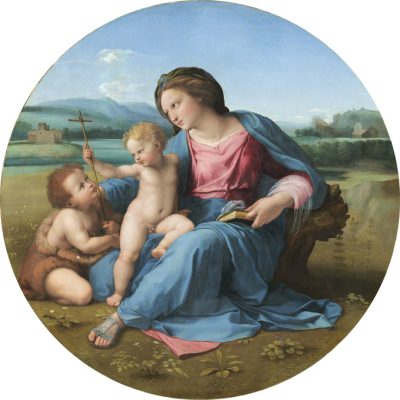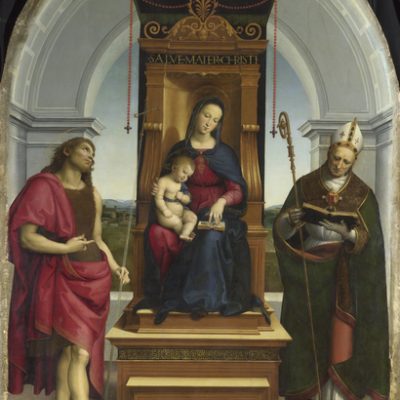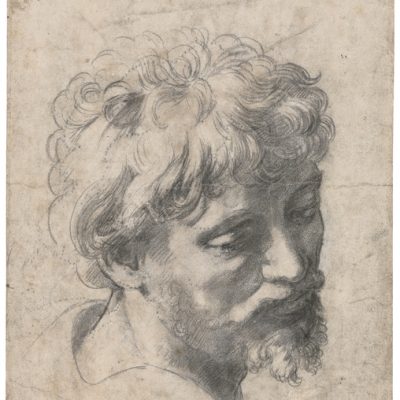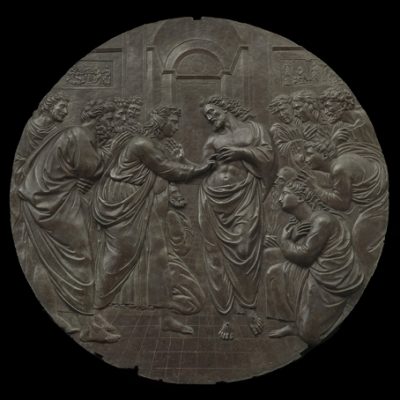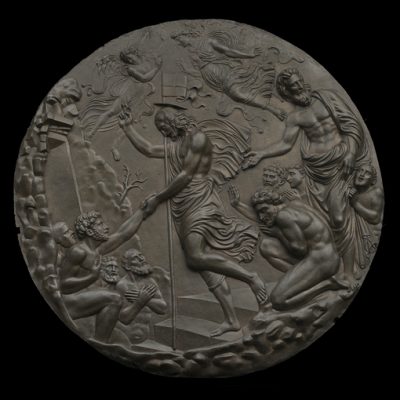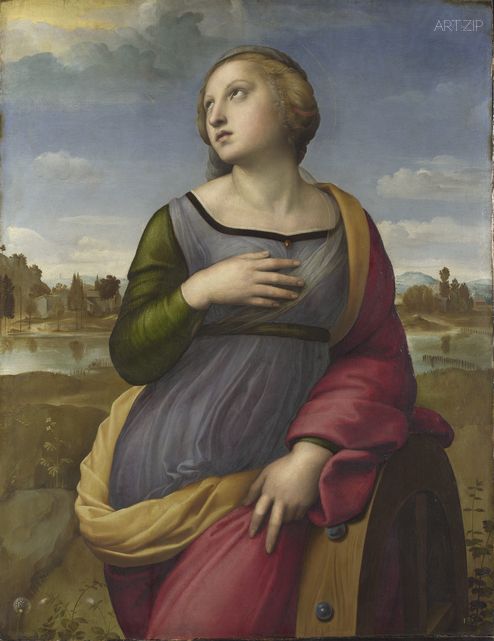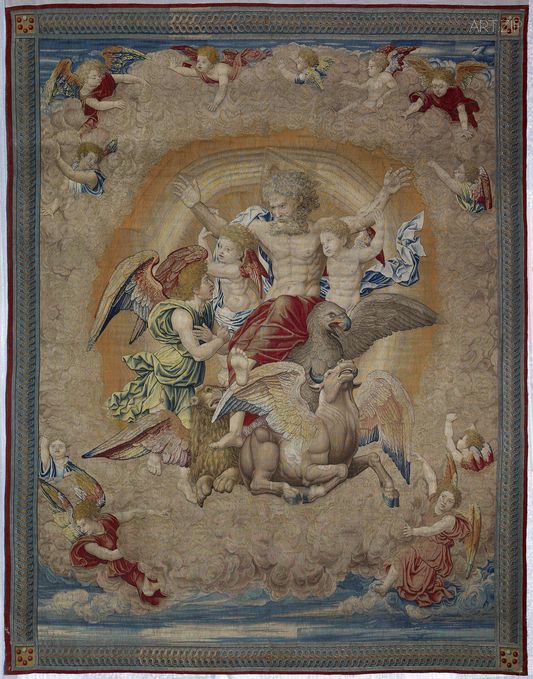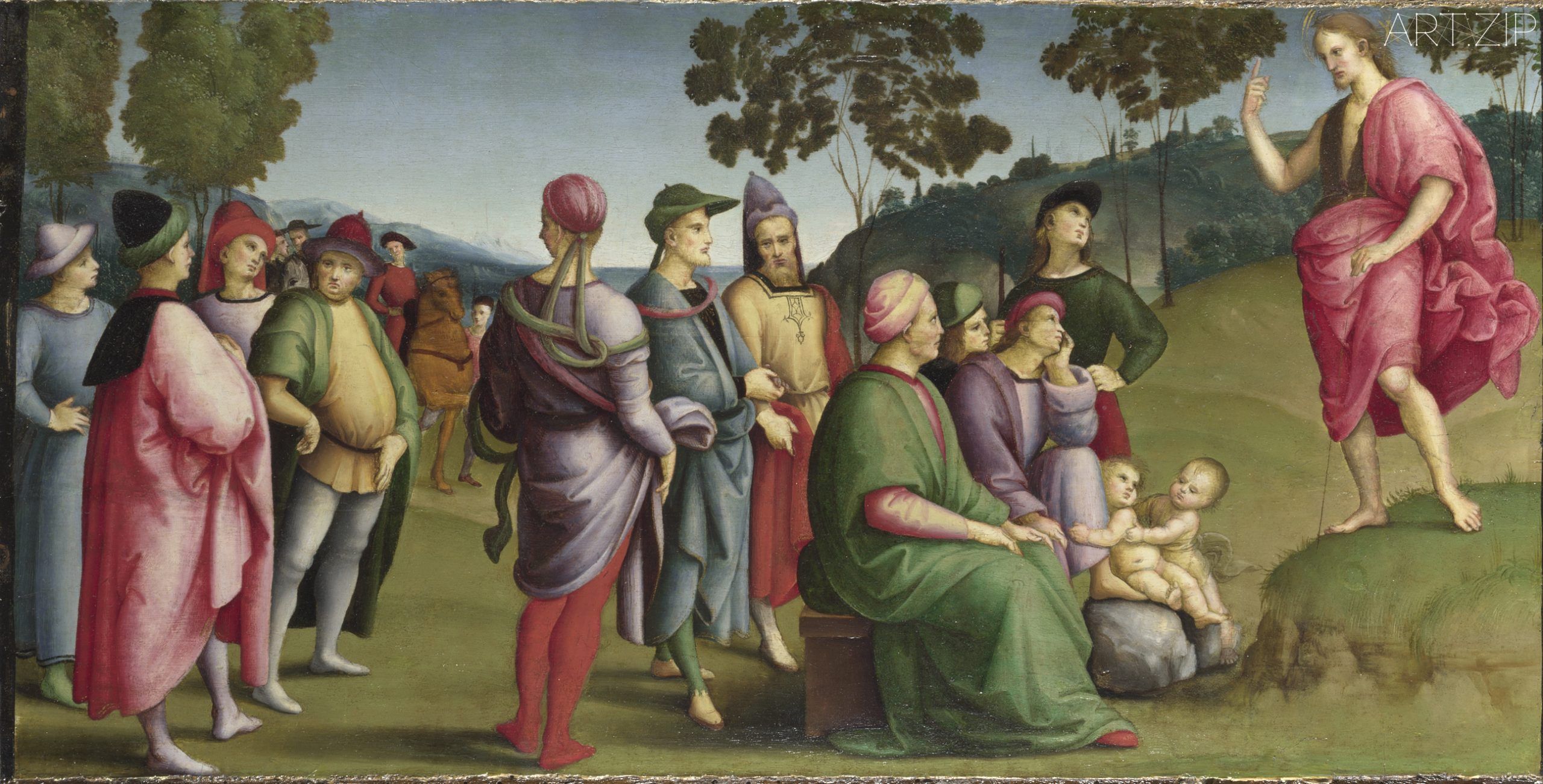
National Gallery
9 April – 31 July 2022
Marking the 500th anniversary of Raphael’s death in 2020 and delayed because of Covid restrictions, the National Gallery presents one of the first-ever exhibitions to explore the complete career of this giant of the Italian Renaissance.
A painter, draughtsman, architect, designer and archaeologist who captured in his art the human and the divine, love, friendship, learning, and power, and who gave us quintessential images of beauty and civilization: Raphael’s life was short, his work prolific, and his legacy immortal.
In his brief career, spanning just two decades, Raffaello Santi (1483-1520) shaped the course of Western culture like few artists before or since. This exhibition examines not just his celebrated paintings and drawings — but also his not so widely known work in architecture, archaeology and poetry, as well as his designs for sculpture, tapestry, prints, and the applied arts. The aim is to do something no previous Raphael exhibition has ever done — explore every aspect of his multimedia activity.
With more than 90 exhibits, all by Raphael, except those in media he did not practice himself but for which he provided design, The Credit Suisse Exhibition: Raphael demonstrates why the artist plays such a pivotal role in the history of Western art.
Loans from across his entire career — many of them unprecedented — are travelling to London from around the world, to join nine works from the National Gallery’s outstanding collection of paintings by Raphael. Among the lenders are: the Louvre, Musei Vaticani, the Galleria degli Uffizi, and the Museo Nacional del Prado. Highlights include Santa Cecilia (about 1515-6, oil on wood, Pinacoteca Nazionale, Bologna) and the Alba Madonna (about 1509—11, oil on wood transferred to canvas, National Gallery of Art, Washington DC.)
Broadly chronological, the exhibition opens with a section devoted to the artist’s early works created in the Marche region of eastern Italy and his birthplace Urbino. These include the drawings for his Saint Nicholas of Tolentino altarpiece (Studies for the Coronation of Saint Nicholas of Tolentino, about 1500-1, black chalk, Palais des Beaux-Arts de Lille) reflecting his lifelong practice of studying from live models.
The exhibition then focuses on Florence where, as well as establishing himself within a new network of clients, Raphael continued to produce works for many other locations, including the Ansidei Madonna (The Virgin and Child with Saint John the Baptist and Saint Nicholas of Bari, 1505, oil on poplar, the National Gallery) for Perugia. A rare gathering of Raphael’s paintings of the Virgin and Child — the genre that he above all made his own — includes pictures dating to his time in Florence, as well as paintings executed during his first years in Rome, where he moved in 1508 to work for one of the great patrons in Western art history, Pope Julius II (reigned 1503-13).
A section follows on Raphael’s arrival in Rome where he quickly gained the patronage of the Sienese banker, Agostino Chigi (1466—1520). Chigi became his most important lay client, commissioning frescoes for his suburban villa, now called the Farnesina, as well as designs for chapels in two Roman churches: Santa Maria della Pace and Santa Maria del Popolo. The exhibition includes two bronze roundels from Santa Maria della Pace, never previously exhibited outside Italy (attributed to Cesarino Rossetti after designs by Raphael the Incredulity of Saint
Thomas; and The Descent into Limbo, both about 1511—12, bronze, Italian State property, Milano, Chiaravalle, Chiesa Abbaziale di Santa Maria.)
A room is then devoted to Raphael’s frescoes for Julius II’s private apartments, or Stanze. This four-room project included monumental, multi-figure compositions depicting biblical subjects, scenes from the history of the Church, allegories of concepts such as Poetry and the great gathering of philosophers known as the School of Allens (1509—10). Drawings on display include a life study for the Greek philosopher Diogenes (about 412-323 BCE) depicted in the School of Athens (Study for Diogenes, about 1508—10, silverpoint on paper primed in beige, rose and light‑purple, Stadel Museum, Frankfurt am Main.) In addition to his demanding commitment to the Stanze, Raphael found time for other commissions, including his penetrating portrait of the sickly and elderly, yet strong-willed Julius II, also exhibited in this room (1511, oil on poplar, the National Gallery, London) which transformed the way the powerful were depicted in Western art.
Raphael’s Roman years saw him applying his talents widely and building a thriving and multi-faceted artistic enterprise. The artist and biographer Giorgio Vasari (1511—1574) described him as a ’universal artist’ in recognition of the mastery he developed across many media. The section explores his innovative work in media such as printmaking, decorative art and tapestry design, as well as his architecture and archaeological work as surveyor of ancient Rome. However, painting remained central to his work, as demonstrated by in the painted variations on the subject of the Holy Family on display in the exhibition.
Several of his original print designs, engraved by Marcantonio Raimondi (c1470/82— c1534), are here displayed alongside his preliminary drawings revealing the immense trouble Raphael took over what others might have regarded as minor works. This includes his Study for the Massacre of the Innocents (about 1509—10, red chalk, The Albertina Museum, Vienna.) Also, included in this section is a single autograph drawing for the border of a salver (Design for the Border of a Salver, about 1510, pen and brown ink, red chalk, The Ashmolean Museum, Oxford.)
As surveyor of ancient Rome to Pope Leo X (reigned 1513-1521) Raphael undertook an ambitious survey of the ancient city with drawings of its principal buildings, having lamented in a letter on display in the exhibition, the destruction of significant ruins as ’the shame of our age’, Letter to Leo , (Raphael, in collaboration with Baldassare Castiglione (1478-1529), 1519, lent by Archivio di Stato di Mantova, Acquisto Castiglioni.)
The exhibition also provides an overview of his work as an architect in Rome, including his most prestigious appointment as architect of the new St Peter’s — the beginnings of the basilica we know today. His designs for private townhouses, or palazzi, are represented by a model of the facade of the Palazzo Branconio dell’Aquila, while his designs for the sprawling Villa Madama, created as a Medici refuge just outside Rome, were the most ambitious of their kind since antiquity but sadly the villa was only partially completed (Elevation Drawing of a Villa Project, about 1516, The Ashmolean Museum, Oxford.)
Raphael’s ground-breaking work as a designer for tapestries is represented by Saint Paul Preaching at Athens (Workshop of, or on behalf of, Pieter van Aelst, active about 1490—1533, after design by Raphael, about 1517—19, Brussels Wool, silk and gilt‑metal‑wrapped thread, Musei Vaticani, Citta del Vaticano.) This was part of his series on the Acts of the Apostles, designed to be hung in the Sistine Chapel under, and in direct competition with Michelangelo’s famous, frescoed ceiling. This series is among his most complex and influential works, bringing the logic of his monumental and meticulously planned narratives of the Vatican frescoes to a different, transportable medium. A digital facsimile of the original painted cartoon for the tapestry (Royal Collection, on permanent loan to the Victoria and Albert Museum), made especially for this exhibition, helps elucidate the collaborative creative process behind this great projects, involving assistant painters and draughtsmen as well, of course, as the weavers in the Netherlands who created the finished works.
The spectacular final room is dedicated to the portraiture of Raphael’s last years. He was generally too busy to take on portrait commissions, unless there was a strong political imperative, as with the Portrait of Lorenzo de’ Medici (1518, oil on canvas, Private Collection.) The portraits he did execute, therefore, tend to have been painted out of friendship or affection, supremely exemplified in his famous Portrait of Baldassare Castiglione(1519, oil on canvas, Musee du Louvre, Paris).
The Credit Suisse Exhibition: Raphael is curated by David Ekserdjian, Professor of History of Art and Film at the University of Leicester; Tom Henry, Professor of History of Art (Emeritus) at the University of Kent; and, for the National Gallery, Dr Matthias Wivel, the Aud Jebsen Curator of Sixteenth Century Italian Paintings.
Dr Matthias Wivel says: “We are delighted that following Its delay because of Covid we are now able to stage this exhibition which marks the 500th anniversary of Raphael’s death in 2020, and is the first ever outside Italy to explore the complete career of this key figure in WeStern art.”
David Mathers, CEO of Credit Suisse International, says: “We are delighted to be supporting The Credit Suisse Exhibition: Raphael at the National Gallery, London. We are thrilled that our clients, employees and partners will be able to experience Raphael’s celebrated paintings and drawings as well as his work in architecture, poetry and design in one of the first ever exhibitions to explore the master’s complete career. We look forward to continuing our long-standing commitment to the National Gallery in support of this much anticipated instalment of its exhibition programme.”
展覽地點:英國國家美術館
展覽時間:2022年4月9日-7月31日
為紀念 2020 年拉斐爾逝世 500 周年,英國國家美術館是有史以來第一個探索這位意大利文藝復興巨人完整職業生涯的展覽之一,儘管因為疫情延遲了兩年。
作為一位畫家、工匠、建築師、設計師和考古學家,拉斐爾在他的藝術中精準捕捉人與神、愛、友誼、學識和力量,並為我們提供了美麗和文明的經典形象。拉斐爾的生命短暫,但他的作品豐富,留給世人許多不朽的遺產。
在他短短二十年的職業生涯中,拉斐爾·桑蒂(1483-1520年)推動了西方文化發展的進程。本次展覽不僅展示了他著名的繪畫和素描,還展示了他在建築、考古學和詩歌方面不那麽廣為人知的作品,以及他的雕塑、掛毯、版畫和應用藝術設計,過往的拉斐爾展覽從未探索過他其他方面的創作。
這次展覽上展出了90多件作品,除了那些他沒有親自實踐但由他提供設計的作品,展品全部由拉斐爾創作,展示了為什麽這位藝術家在西方藝術史上扮演著如此舉足輕重的角色。
此次展出囊括了眾多史無前例的作品,除了九幅英國國家美術館的館藏作品以外,從世界各地借出的拉斐爾傑作來自盧浮宮、梵蒂岡博物館、烏菲茲美術館和普拉多國家博物館。尤為突出的是來自博洛尼亞國家美術館的《聖澤利亞(約 1515-6 )》和來自華盛頓特區國家美術館的《 阿爾巴聖母像(約 1509-11 )》。
展覽以一個部分開始,大致按時間順序,專門介紹藝術家在意大利東部的馬爾凱雷皮恩和他的出生地烏爾比諾創作的早期作品。其中包括他的托倫蒂諾的聖尼古拉祭壇畫(托倫蒂諾聖尼古拉加冕研究,約 1500-1,黑色粉筆,裏爾美術宮),此作品反映了他畢生學習真人模特的實踐。
展覽隨後將重點放在佛羅倫薩,除了建立自己的新客戶網絡外,拉斐爾還繼續為許多其他地方製作作品,包括 為佩魯賈創作的 安西迪·麥當娜(聖母子與施洗者聖約翰和巴裏的聖尼古拉斯, 1505,白楊油,國家美術館。)拉斐爾罕見的聖母子畫集——此他首創的流派——包括可追溯到他在佛羅倫薩時期的照片,以及他在羅馬的第一年創作的畫作,他於 1508 年搬到那裏為西方藝術史上一位偉大的贊助人教皇朱利葉斯二世(1503-13 年在位)工作。
接下來是拉斐爾抵達羅馬的部分,在那裏他迅速獲得了錫耶納銀行家阿波斯蒂諾·奇皮(1466-1520 年)的贊助。 奇皮成為他最重要的非專業客戶,為他的郊區別墅創作壁畫(現在稱為法爾內塞別墅),以及為兩座羅馬教堂的小教堂設計:和平之後教堂以及人民聖母教堂。展覽包括兩個來自和平之後教堂的青銅圓環——以前從未在意大利以外的地方展出過(根據拉斐爾的設計歸功於 塞薩利諾·羅塞蒂聖托馬斯 和 墜入地獄邊緣,約 1511-12 年,青銅,意大利國有財產,米蘭,基亞拉瓦萊,安康聖母教堂又稱聖母大殿。)
緊隨其後的一個房間專門用於為朱利葉斯二世的私人公寓 (或 Stanze 詩節)繪製拉斐爾的壁畫。這個有四個房間的項目包括描繪聖經主題、教會歷史場景、詩歌等概念的寓言和被稱為艾倫斯學派 (1509-10) 的哲學家的前集會的不朽的、多人物的作品。展出的畫作包括雅典學院中描繪的希臘哲學家第歐根尼(約公元前 412-323 年)的生平研究(第歐根尼研究,約 1508-10 年,銀尖紙本,底色為米色、玫瑰色和淡紫色,施塔德爾博物館, 美因河畔法蘭克福。)除了對斯坦澤的嚴格承諾外,拉斐爾還抽出時間進行其他委托,包括他對病弱和年邁但意誌堅定的朱利葉斯二世的深刻肖像,也在這個房間展出(1511 年,油畫楊樹,倫敦國家美術館),它改變了西方藝術中描繪強者的方式。
拉斐爾在羅馬的歲月見證了他廣泛運用自己的才能,並建立了一個蓬勃發展的多方面藝術事業。藝術家兼傳記作家喬治·瓦薩裏(1511-1574 年)將他描述為“全能藝術家”,以表彰他在多種媒體上的精湛技藝。該部分探討了他在版畫、裝飾藝術和掛毯設計等媒體方面的創新工作,以及他作為古羅馬測量員的建築和考古工作。然而,繪畫仍然是他作品的核心,正如展覽中展示的關於神聖家族主題的繪畫變化所證明的那樣。
由馬爾坎托尼奧·雷蒙迪 (c1470/82-c1534) 雕刻的他的一些原始版畫設計與他的初步圖紙一起在這裏展示,揭示了拉斐爾在其他人可能認為是次要作品的過程中遇到的巨大麻煩。這包括他的《無辜者大屠殺研究》(約 1509-10 年,紅色粉筆,維也納阿爾貝蒂娜博物館)。此外,本節還包括一張托盤邊緣的親筆簽名圖(托盤邊緣設計,約 1510 年,鋼筆和棕色墨水,紅色粉筆,牛津阿什莫爾博物館。)
作為教皇利奧十世(1513-1521 年在位)的古羅馬勘測員,拉斐爾對這座古城進行了一項雄心勃勃的勘測,並繪製了其主要建築的圖紙,他在展覽中展出的一封信中感嘆重大遺址的破壞是“我們這個時代的恥辱”,給 Leo 的信,(拉斐爾,與巴爾達薩雷·斯蒂謬內(1478-1529) 合作,1519 年,借由 Archivio di Stato di Mantova,Acquisto Castiglioni。)
展覽還概述了他作為羅馬建築師的工作,包括他作為新聖彼得大教堂最負盛名的建築師——我們今天所知道的大教堂的開端。他對私人聯排別墅或宮殿的設計以布蘭科尼奧·德爾·阿奎拉宮的立面模型為代表,而他為羅馬郊外的美第奇療養院建造的龐大的夫人別墅的設計是同類中最雄心勃勃的自古以來,但遺憾的是別墅只完成了部分(別墅項目的立面圖,約 1516 年,牛津阿什莫林博物館。)
拉斐爾作為掛毯設計師的開創性工作由雅典的聖保羅布道會代表(由彼得·範·阿爾斯特或代表彼得·範·阿爾斯特的工作室,活動於 1490-1533 年左右,由拉斐爾設計,約 1517-19 年,布魯塞爾羊毛,絲綢和金屬纏繞的線,梵蒂岡博物館,梵蒂岡城。)這是他的使徒行傳系列的一部分,旨在與米開朗基羅著名的壁畫天花板直接競爭在西斯廷教堂下面.這個系列是他最復雜也是最有影響力的作品之一,將他對梵蒂岡壁畫的不朽和巧奪天工的敘述帶入了一種不同的、便攜式的媒介。專門為本次展覽製作的掛毯原畫漫畫(皇家收藏,永久借給維多利亞和阿爾伯特博物館)的數字復製品,有助於闡明這一偉大項目背後的協作創作過程,包括助理畫家和繪圖員,當然,作為創作成品的荷蘭織布工。
最後一個嘆為觀止房間專門用於描繪拉斐爾最後幾年的肖像。他通常忙於接受肖像委托,除非有強烈的政治需要,例如洛倫佐·德·美第奇的肖像(1518 年,布面油畫,私人收藏)。因此,他執行的肖像往往有出於友誼或感情而繪畫,在他著名的巴爾達薩雷·卡斯圖廖內肖像(1519 年,布面油畫,巴黎盧浮宮博物館)中得到了極大的體現。
Edited by Shannon
編輯 x 王昱雯

